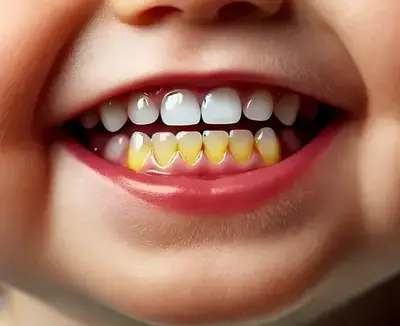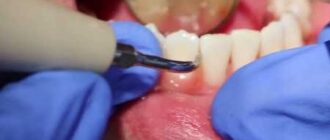Seeing your baby’s first tooth appear is an exciting milestone, but what if you notice that those tiny teeth start turning brown? This can be concerning for any parent, but rest assured that you’re not alone, and there are answers. In this article, we’ll explore why your baby might have brown teeth, common causes, real-life cases, and what experts suggest to address this issue.
The Brown Tooth Mystery: Common Causes
Brown discoloration of a baby’s teeth can occur for a variety of reasons. Here are some of the most common culprits:
- Early Childhood Cavities: The most frequent cause of brown teeth in babies is early childhood cavities, also known as baby bottle tooth decay. This is typically caused by prolonged exposure to sugary drinks or milk, especially if the child falls asleep with a bottle. The sugars interact with bacteria in the mouth to produce acids that wear down enamel, leading to brown or black stains.
- Medications and Supplements: Some medications, such as iron supplements, can lead to staining on a baby’s teeth. While this type of staining may be superficial, it can still appear alarming. Antibiotics like tetracycline are also known to cause permanent discoloration, but these are typically avoided during pregnancy and infancy for this reason.
- Enamel Hypoplasia: Sometimes, brown discoloration can be due to a condition called enamel hypoplasia, where the enamel of the teeth is thinner or poorly formed. This can make teeth more susceptible to staining and decay. Enamel hypoplasia can be caused by factors like premature birth, malnutrition, or certain health conditions.
- Poor Oral Hygiene: Babies need their teeth cleaned too! Without consistent oral care, bacteria can build up and lead to the formation of plaque and tartar, resulting in brown or yellow discoloration.
Real Stories, Real Parents
Case 1: Amelia’s Baby and Iron Supplements
Amelia, a mother of a 1-year-old, was giving her daughter iron supplements as recommended by her pediatrician. Within a few months, she noticed a brownish tint on her baby’s teeth. “At first, I thought it was cavities, but our dentist reassured us that it was just superficial staining from the iron,” she said. Amelia was advised to gently clean her baby’s teeth with a soft-bristled toothbrush and a bit of water, and the stains gradually faded.
Case 2: The Baby Bottle Dilemma
Carlos, a father of twin boys, noticed one of his sons had brown spots on his front teeth. After visiting the dentist, he learned that letting his son fall asleep with a bottle of milk was the likely cause. “It was a tough habit to break, but we switched to a water-only bottle at bedtime,” Carlos shared. The dentist performed a fluoride treatment, and Carlos worked on improving his son’s oral care routine. Though the stains didn’t disappear completely, they did not progress.
Expert Insights
Dr. Laura Simmons, a pediatric dentist, emphasizes that prevention is key. “Parents often underestimate how important it is to clean their baby’s teeth as soon as they come in,” she explains. Dr. Simmons advises that even before the first tooth erupts, parents can gently wipe the gums with a clean, damp cloth. Once teeth start appearing, a baby toothbrush with a tiny smear of fluoride toothpaste can be used.
How to Address Brown Teeth in Babies
If your baby’s teeth are turning brown, it’s important to consult with a dentist. Here are some steps you can take:
- Improve Oral Hygiene: Start cleaning your baby’s teeth as soon as they appear. Use a soft baby toothbrush and a small amount of fluoride toothpaste—about the size of a grain of rice.
- Reduce Sugar Exposure: Avoid giving your baby sugary drinks, especially at bedtime. Water is the safest option for nighttime bottles.
- Visit a Pediatric Dentist: Regular dental check-ups can help identify and address any dental issues before they become serious. Dentists can also provide fluoride treatments or other interventions if necessary.
- Dietary Adjustments: If your baby is on iron supplements, talk to your pediatrician about how to minimize the risk of staining. Using a straw or syringe to administer liquid iron can help keep it away from the teeth.
The Emotional Toll on Parents
Seeing brown spots on your baby’s teeth can feel like a reflection of something you’ve done wrong, but it’s important to remember that this is a common issue and not necessarily a sign of neglect. Dr. Simmons reassures parents, “It’s not about blame. Babies’ teeth are very vulnerable, and even the most diligent parents can run into challenges.” Addressing the problem early on can make a big difference, both for your baby’s health and your peace of mind.
Prevention: Your Best Defense
Preventing brown teeth in babies often comes down to early and consistent care. Here are some simple preventive measures:
- Start Early: Begin oral hygiene practices before the first tooth even erupts. Wiping gums with a clean, damp cloth after feedings can help reduce bacteria buildup.
- Watch the Bottle: Avoid letting your baby fall asleep with a bottle containing anything other than water.
- Regular Check-ups: The American Academy of Pediatric Dentistry recommends that a child should see a dentist by their first birthday or within six months of the first tooth appearing.
Final Thoughts: Don’t Panic, Act!
Brown teeth in babies can be alarming, but they’re not uncommon. With proper care, many cases of discoloration can be managed or even prevented. Early childhood is full of challenges, and dental health is just one part of the journey. By staying informed and proactive, you can help ensure your baby’s teeth stay healthy and bright.
If you’ve noticed any discoloration, don’t hesitate to reach out to a pediatric dentist for guidance. Remember, a healthy smile starts early—and your efforts today can set the foundation for a lifetime of good dental habits.






